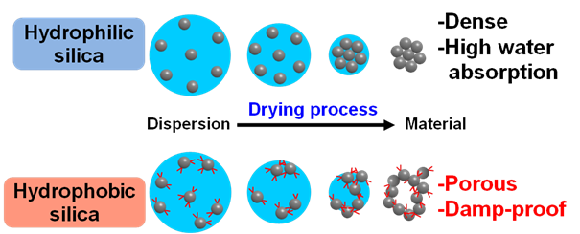The hydrophobization of nanoparticles impacts their structuration in aqueous dispersions and how this structure resists drying stress. To understand and control this phenomenon, hydrophilic silica particles were hydrophobized directly in water using a range of organosilane precursors, with a precise control of the grafting density. The resulting nanostructure in water as well as its evolution during progressive drying was precisely analyzed by a combination of small-angle X-ray scattering (SAXS) and cryo-microscopy (cryo-TEM.
At the fundamental level, because the hydrophobic character of the silica surfaces could be varied continuously through a precise control of the grafting density, we were able to study how the hydrophobic interactions change particles interactions, i.e. the way they interact with each other, and how this modifies the aggregates structures.
Practically, this opened a new route to tailor the final structure, the residual porosity, and the damp-proof properties of the fully dried silica. This method is much simpler and “greener” than traditional ones based on solvent exchanges or supercritical drying (aerogels). For example, regardless of the nature of the hydrophobic precursor, a grafting density of 1 grafter per nm2 optimized the interparticle interactions in solution in view to maximize the residual porosity in the dried material (0.9 cm3/g) and reduced the water uptake to less than 4% in weight compared to the typical value of 13% for hydrophilic particles (at T = 25 °C and relative humidity = 80%).

To know more : Hydrophobization of Silica Nanoparticles in Water : Nanostructure and Response to Drying Stress
Solenn Moro, Caroline Parneix, Bernard Cabane, Nicolas Sanson , and Jean-Baptiste d’Espinose de Lacaillerie, Langmuir 2017, 33, 4709.
link : http://pubs.acs.org/doi/abs/10.1021/acs.langmuir.6b04505


